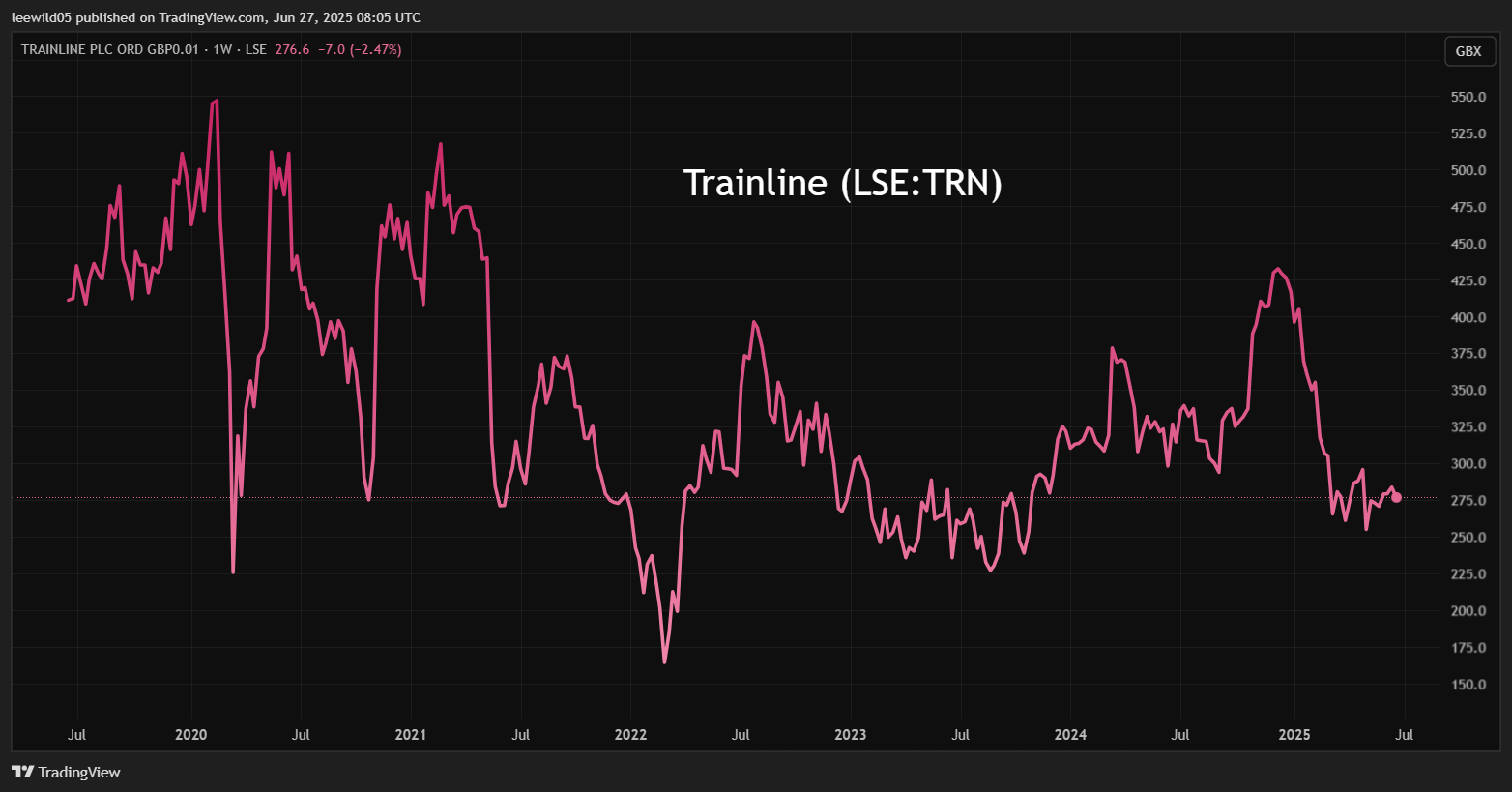Stockwatch: unpacking this growth share conundrum
Around a low point in its historic range and with a strong market position, analyst Edmond Jackson thinks this company merits attention.
27th June 2025 11:18
by Edmond Jackson from interactive investor

While many shares have re-rated lately, Trainline (LSE:TRN) is a mid-cap interestingly left behind at 273p. It’s been trading in a volatile-sideways range the last three months, well down from 430p in December 2024 and its mid-2019 flotation price of 350p.
- Invest with ii: Open a Stocks & Shares ISA | Top ISA Funds | ISA Offers & Cashback
At first sight this looks anomalous relative to consensus forecasts for a near 40% advance in normalised earnings per share (EPS) to 19.5p in its current year to end-February 2026, even if EPS growth moderates to 13% growth to 22.1p in 2027. This assumes net profit of £87 million, rising to near £94 million and implies a forward price/earnings (PE) ratio of 14x, easing near 12x. The price/earnings-to-growth (PEG) ratio is an attractive 0.6x.
Profitability was only achieved in the February 2023 year, then EPS grew by near 90% in each of the last two financial years. Yet there is no dividend despite a sound cash flow record going back further than profits. As a technology-driven share, Trainline’s price-to-book value is over 4x net assets, which constitute 173% goodwill/intangibles.
The board’s prioritising buybacks for shareholder “return” further focuses attention on EPS, although to my mind a rising dividend policy would help improve a sideways-volatile chart over recent years:

Source: TradingView. Past performance is not a guide to future performance.
Strictly it remains early years to be confident about projections, yet earnings quality is implied by an operating margin near 20% in Trainline’s February 2025 financial year plus a 24% return on capital. Despite technology investment as you would expect, overall capital expenditure is light and £81 million net debt not onerous.
Three decades to get where it is today
Scepticism not unreasonably relates to the business having been started as long ago as 1997 - within the Virgin Group - with online ticket sales commencing from 1999. Stagecoach bought a 49% stake, but this was sold back to Virgin and National Express. Then from mid-2006 the company went through two private equity owners before floating.
A charitable explanation of 25 years to profitability would be that e-tickets have taken time to achieve majority usage for rail and bus travel. Advantages include easy purchasing online instead of queuing at a station or searching for a ticket machine. They can also be stored on smartphones and exchanged or refunded online. Booking in advance may also yield cheaper tickets.
- Three reasons UK outperformance can continue
- Sign up to our free newsletter for investment ideas, latest news and award-winning analysis
80% of Trainline reviewers on Trustpilot give it five or four stars, but within the 12% who give it one star, complaints include failing to show the QR code after booking, the refundable status of tickets being changed, a refund not made available for a delayed or cancelled train, and lately the app becoming harder to use.
So, it’s unclear whether the market for e-tickets is starting to mature, its growth spurt moderating versus an older demographic preferring paper tickets for simplicity and surety. Trainline’s revenue growth rate is indeed already declining, down from 73% in its year to February 2023 to 21% to 2024 and 11% to February 2025.
Trainline - financial summary
Year end 28 Feb
| 2020 | 2021 | 2022 | 2023 | 2024 | 2025 | |
| Turnover (£ million) | 261 | 67.1 | 189 | 327 | 397 | 442 |
| Operating profit (£m) | -68.2 | -99.7 | -10.3 | 27.6 | 55.6 | 85.6 |
| Net profit (£m) | -80.9 | -91.3 | -11.9 | 21.2 | 34.0 | 58.3 |
| Operating margin (%) | -26.1 | -149 | -5.5 | 8.5 | 14.0 | 19.4 |
| Reported earnings/share (p) | -17.5 | -18.9 | -2.9 | 3.9 | 7.1 | 12.7 |
| Normalised earnings/share (p) | -10.6 | -15.5 | -2.9 | 3.9 | 7.5 | 14.0 |
| Operational cashflow/share (p) | 13.0 | -25.2 | 41.5 | 8.4 | 25.4 | 30.0 |
| Capital expenditure/share (p) | 6.1 | 5.5 | 6.1 | 7.4 | 8.3 | 9.2 |
| Free cashflow/share (p) | 6.9 | -30.7 | 35.4 | 0.9 | 17.1 | 20.8 |
| Return on total capital (%) | -12.8 | -18.1 | -2.5 | 6.3 | 12.1 | 24.1 |
| Cash (£m) | 92.1 | 36.6 | 68.5 | 57.3 | 91.1 | 76.8 |
| Net debt (£m) | 64.7 | 233 | 85.0 | 96.2 | 61.2 | 81.0 |
| Net assets (£m) | 373 | 284 | 259 | 291 | 312 | 283 |
| Net assets per share (p) | 77.6 | 59.0 | 54.0 | 60.5 | 66.2 | 63.5 |
Source: company accounts.
The 7 May annual results did not explicate this trend, just noted a 12% rise in ticket sales equating with the 11% revenue rise. Similarly, the ticket growth rate declined in line with revenue the previous two financial years. Were such a deceleration to continue, growth to February 2026 could be quite meaningless in inflation-adjusted terms. As yet, only 2% growth is the consensus forecast, rising to over 6% out to 2027. Revenue growth is therefore at odds with current earnings expectations, hence growth-oriented investors are understandably cautious that the attractive PEG ratio may expire.
At least market share rose in the last year from 47% to 52%, with 27 million active customers in Europe and 18 million in the UK. Unpacking this, separate data suggests the app had an 86% share in the UK, if down on 90% in March. As yet, UK rivals include Ticketer, National Rail’s website and Omio and Lumo - with no sign of serious new entrants.
The group operates its own brands, Trainlineand Qjump,and also a rail business travel service marketed directly to corporations and the travel industry. The software can communicate elsewhere, enabling companies to arrange rail travel across Europe. International rail ticket sales via this approach rose 63% in 2024 and a third of UK rail operators use it to manage their bookings.
- City analyst reveals price target for BT and Vodafone shares
- How minimum pension age rise to 57 might affect you
Indeed,Trainline is Europe’s most downloaded rail app with 27 million customers, and here management sees a significant long-term opportunity - repeating initial success in Spain, France and Italy, where over £10 billion equivalent sales are independently projected for those countries by 2030. This seems the chief growth opportunity – if hard to gauge competition – versus 18 million active rail customers in the UK.
In Spain, ticket sales have more than doubled for two years and the share of top routes has risen to 12%.
A rise in operating margin from 14.0% to 19.4% helped February 2025 operating profit rise 54% to £86 million and adjusted EPS by 56% to 19.2p. There was excellent conversion of operating profit to free cash flow which rose 20% to £110 million.
The shares did rise from 272p to over 279p on 6 June after news that it’s been selected by Rail Delivery Group in support of four digital pay-as-you-go trials, to run for nine months across the Northern Rail and East Midlands Railway networks from this autumn. It’s unclear what extent of revenue benefit may arise from a roll-out of pay-as-you-go, but at least it is potentially a way to bolster UK growth.
Possibly a sound income share
A perceptive dilemma for Trainline shares is whether revenue growth consolidates in mid-single-digit percentage rates, or current initiatives feed through for a boost in maybe two years or so. Capital growth-driven investors should ideally prioritise a strong top line, given earnings can be relatively more variable.
The company’s cash flow profile looks excellent for shareholder returns but these currently are focused on buybacks. That may make sense while the shares are moderately rated – and currently at the low end of their trading range – but is effectively propping an EPS growth profile.
We thus see another example of how a share can fall between two stools, appealing neither convincingly for growth nor income.
I’m therefore not unsurprised that Trainline has been left behind in the wider market advance; its profile having a “wait and see” feeling to the growth path the board has chosen to emphasise above income.
Around a low point in its historic range and with a strong market position, I think Trainline’s updates merit attention but I would like to see more proof that revenue growth can average at least 5% – and the board consider dividends – to upgrade my current sense that the shares merit “hold” rather than “buy”.
Edmond Jackson is a freelance contributor and not a direct employee of interactive investor.
These articles are provided for information purposes only. Occasionally, an opinion about whether to buy or sell a specific investment may be provided by third parties. The content is not intended to be a personal recommendation to buy or sell any financial instrument or product, or to adopt any investment strategy as it is not provided based on an assessment of your investing knowledge and experience, your financial situation or your investment objectives. The value of your investments, and the income derived from them, may go down as well as up. You may not get back all the money that you invest. The investments referred to in this article may not be suitable for all investors, and if in doubt, an investor should seek advice from a qualified investment adviser.
Full performance can be found on the company or index summary page on the interactive investor website. Simply click on the company's or index name highlighted in the article.
Disclosure
We use a combination of fundamental and technical analysis in forming our view as to the valuation and prospects of an investment. Where relevant we have set out those particular matters we think are important in the above article, but further detail can be found here.
Please note that our article on this investment should not be considered to be a regular publication.
Details of all recommendations issued by ii during the previous 12-month period can be found here.
ii adheres to a strict code of conduct. Contributors may hold shares or have other interests in companies included in these portfolios, which could create a conflict of interests. Contributors intending to write about any financial instruments in which they have an interest are required to disclose such interest to ii and in the article itself. ii will at all times consider whether such interest impairs the objectivity of the recommendation.
In addition, individuals involved in the production of investment articles are subject to a personal account dealing restriction, which prevents them from placing a transaction in the specified instrument(s) for a period before and for five working days after such publication. This is to avoid personal interests conflicting with the interests of the recipients of those investment articles.